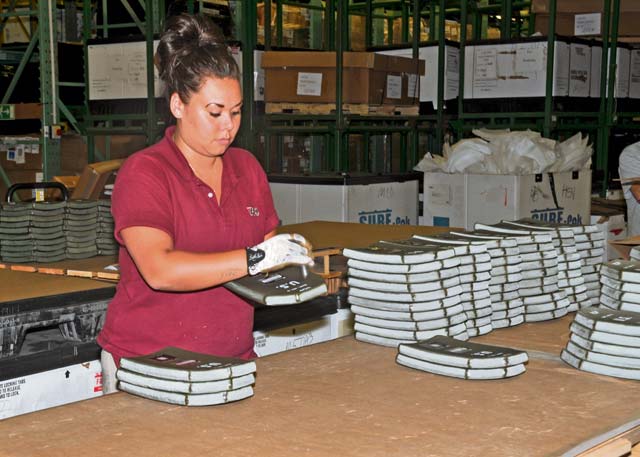
Michell Day, a material handler with R4’s Non-Destructive Test Equipment mobile team, tests the structural stability of a ballistic armor plate Aug. 29 on Rhine Ordnance Barracks. Eight members of the NDTE mobile team traveled to Kaiserslautern to conduct required inspections on the more than 50,000 armor plates in circulation throughout U.S. Army Europe.
Soldiers who have deployed in support of Operation Enduring Freedom, Operation Iraqi Freedom and Operation New Dawn have the shared experience of being issued and reissued ballistic plates for their body armor. Part of ensuring plates are combat ready involves a detailed inspection process to identify defective plates and remove them from circulation.
Until recently, the process of ensuring plates being issued fell within their inspection window meant the 21st Theater Sustainment Command spent time and money sending plates to Sierra, Calif., to be inspected before being shipped back to Europe for deploying Soldiers.
“What we had that needed to be scanned would be shipped back to the states,” said Carla Stovall, a logistics management specialist with the 21st TSC’s Support Operations. “Anytime there was a deploying unit we would send our requirements back with the amounts that we would need, and they would ship over inspected plates.”
Now the 21st TSC has acquired an Armor Inspection System, a system that uses X-rays to scan plates in order to identify deficiencies within them. Having the new system allows for a mobile team of Non-Destructive Test Equipment personnel to be flown in to inspect and certify the plates used throughout U.S. Army Europe.
“This is actually the first fixed site with an AIS that we have where we can actually jump the mobile team right into the inspection process,” said Bruce Cardell, the NDTE team lead. “The intent is to take a mobile team, drop them into a fixed site, process all of the plates they have, and place the plates back on the same cycle and same inspection window while at the same time taking the bad plates out of service.”
“Now the only plates that are being sent back to the states are the unserviceable plates, which will go back into circulation once they are repaired” or be destroyed if they cannot be repaired, Cardell added.
The cost saving advantage of having a fixed AIS in Kaiserslautern is substantial, Cardell said.
“If you look at the big picture, it’s significant; the logistical cost, the transportation and the resources it requires to get things from point A to point B is enormous,” he said.
In the past, it was common to have a large number of plates in the warehouse that were considered not issuable because of the length of time that had passed since their last inspection.
“Having available stock makes a big difference when you have deployers,” Stovall said. “We need to have the right plates for the Soldier when they’re ready to deploy, so they have that piece of mind that they’re deploying with the best.”
Currently, the mobile team is on the ground on Rhine Ordnance Barracks until Oct. 8, inspecting the more than 50,000 plates from across Europe in an effort to maximize the stock of plates eligible for deployment. The current policy only allows for plates to be issued to deploying Soldiers if they have been inspected within the previous nine months. Having the NDTE inspection team on site “should be a recurring thing,” Stovall said. “All of the plates that are considered issuable will all expire at the same time, so we would want to have that taken care of before the nine months are up.”
“We look at the operation as being a lifeline (that) gives the Soldiers and commanders the reassurance that they have the best equipment in theater,” Cardell said. “It gives them that reassurance that they have the best type of plate protecting them in the field.”
Once complete, the plates which pass inspection will be sent back to the various central issuing facilities throughout Europe and will be ready to protect Soldiers deploying all throughout the world.







